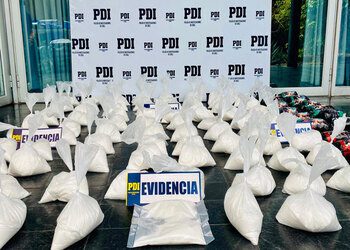Record seizures of ketamine in Chile show how the drug is making its way into the country’s already extensive synthetic drug market.
On July 26, the Anti-Narcotics and Organized Crime Squad of Chile’s Investigative Police (Policía de Investigaciones de Chile – PDI) seized 96 kilograms of powdered ketamine in the Arica y Parinacota region, bordering Peru.
This is the largest seizure of ketamine ever recorded in the country, according to a press release issued by the Attorney General’s Office.
SEE ALSO: Meth, Fentanyl, Ecstasy: Synthetic Drugs Flourish in Latin America
The 10 individuals arrested during the operation were using small boats to smuggle ketamine shipments through Caleta Vítor, a fishing cove near the city of Arica.
Ketamine seizures are becoming more frequent across the country, rising from just 7 kilograms seized in 2017 to 381.5 kilograms seized in 2023, according to PDI data.
“We have a situation today that concerns us in the area of synthetic drugs,” Ignacio Castillo, director of the Attorney General’s Specialized Unit on Organized Crime and Drugs, told InSight Crime. “There has been a significant increase in the seizure and, therefore, consumption of substances such as ketamine.”
At Nuevo Pudahuel airport, located in the Metropolitan Region of Santiago, the PDI seized 117 kilograms of drugs in the first six months of the year, 77 kilos of which were ecstasy, followed by 16 kilos of ketamine, and smaller quantities of other substances. Drug seizures in the first half of 2024 have already surpassed the 108 kilograms seized during the whole of 2023 and the 82.7 seized in 2022.
Ketamine, an anesthetic drug often used in the veterinary field, is often sold as an injectable solution, from which its powder form can be extracted. Like other pharmaceutical substances, it can be stolen or diverted from the legal market.
There have been several cases of theft from laboratories and clinics recorded in Chile, such as 52 kilograms and 28,360 ampoules of ketamine stolen from the Sanderson laboratory in Santiago in 2021, or 128 kilos stolen from the Biosano laboratory in 2020, according to an investigation by CIPER Chile.
However, many of the loads seized are traced to neighboring countries, especially on the country’s northern borders.
InSight Crime Analysis
The increase in ketamine trafficking in Chile is mainly due to its established market for synthetic drugs and an increase in drug trafficking from neighboring countries.
The synthetic drug market in South America has remained relatively small compared to other regions of the world, according to the World Drug Report 2024 published by the United Nations.
However, Chile has a relatively high per capita purchasing power, and drugs are sold at higher prices compared to other illicit markets in the region. As a result, the country has a lucrative market for synthetic drugs.
SEE ALSO: Tusi: The Pink Drug Cocktail That Tricked Latin America
Tusi, also known as “tusibi” or “pink cocaine,” has become one of the most popular. The name refers to different drugs throughout the region, but in Chile, most of the tusi seized is made from ketamine, according to the Attorney General’s Office Drug Trafficking Observatory. Several laboratories producing tusi have been dismantled in recent years.
The availability of ketamine has also risen as a result of new trafficking routes in the north of the country.
At the end of 2020, police in the Tarapacá region of northern Chile linked several shipments of ketamine to the expansion of the Venezuelan gang, Tren de Aragua.
“It is a relatively new phenomenon of drug trafficking … associated with this migratory flow that has generated illicit businesses around it,” Castillo told InSight Crime.
Tren de Aragua took advantage of the criminal infrastructure it used for migrant smuggling, mainly in border areas, to establish local drug trafficking operations and expand its criminal portfolio.
Other routes, especially maritime and air routes, feed the synthetic drug market in the rest of the country. Quantities of MDMA, the main product being trafficked, are also on the rise. In 2023, Chilean authorities made the largest ecstasy seizure in South America, 184 kilos transported from Belgium to the port of Valparaiso.
“We have observed the greatest entry of ecstasy pills through cross-border sectors such as the Pudahuel airport in the Metropolitan Region or through port areas, in Valparaiso or San Antonio, where large volume seizures have also been made from Europe,” Roberto Contreras Puelles, an organized crime researcher at the University of Chile, told InSight Crime.
Featured image: Chile’s Investigative Police seized 96 kilograms of ketamine near the border with Peru. Credit: Policía de Investigaciones de Chile (PDI)
Source link : http://www.bing.com/news/apiclick.aspx?ref=FexRss&aid=&tid=66b0ad44506c407b83f7f35890bfe070&url=https%3A%2F%2Finsightcrime.org%2Fnews%2Fketamine-trafficking-rising-chile-thriving-synthetic-drugs-market%2F&c=8268052783206414752&mkt=en-us
Author :
Publish date : 2024-08-02 07:53:00
Copyright for syndicated content belongs to the linked Source.
